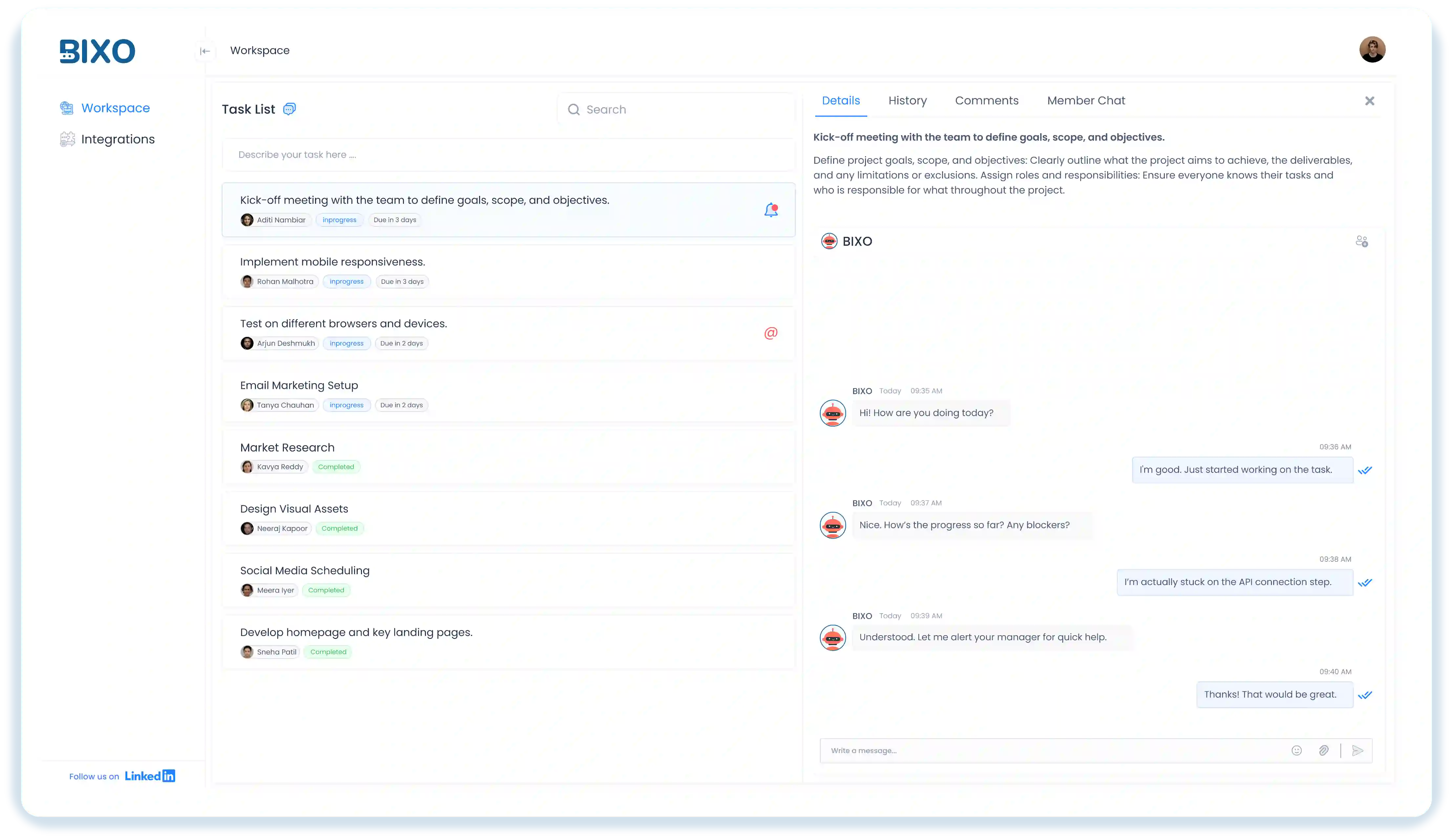
Table of Content
Focus on what matters. BIXO handles the rest!

Have you ever managed a project and noticed that everyone had their own idea of what to do? That is where project scope plays a vital role. It sets clear goals, outlines boundaries, and ensures your entire team moves in the same direction. Without it, projects can quickly lose focus and fall behind schedule.
In this blog, you will learn what project scope is, why it matters, and how to define it the right way to make your projects more organised and successful.
What Is Project Scope?
Project Scope is the clear outline of what your project will include and what it will not. It explains the goals, tasks, deadlines, and results you aim to achieve. In simple words, it sets the boundaries for your work so that everyone on your team knows exactly what needs to be done. When your project has a well-defined scope, it becomes easier to plan, manage, and deliver the right outcomes.
You can think of project scope as a roadmap that guides your team from start to finish. It helps you avoid confusion, control changes, and stay within time and budget. Without a clear scope, your project may drift in different directions, causing delays and missed expectations. A strong scope gives you clarity and keeps your project moving smoothly toward success.
Why Defining Scope for a Project is Important for Success?
Defining project scope is important for success. It sets clear goals, avoids confusion, and keeps the project focused. With a clear scope, you can:
- Avoids last-minute changes
- Plan time and budget more accurately
- Make sure everyone is on the same track.
- Spot potential problems early.
- Focus on what really needs to be done, no more, no less
Without a clear scope, even small projects can lead to confusion and delays.
How to Define the Scope of the Project in by Step-by-Step Process?
Defining your project’s scope is one of the most important steps to ensure success. A clear scope sets boundaries, outlines goals, and helps your team know exactly what needs to be done. By following a step-by-step process, you can project plan effectively, avoid misunderstandings, and keep your project on track from start to finish.

Set Clear Project Goals
First, write down the project objectives. What do you need to achieve in this project? Set clear and realistic goals with deadlines, so everyone understands what you are working towards. Clearly defined goals also make it easier to measure progress and success while keeping your team focused and motivated throughout the project.
List All Deliverables
Clearly state all the project deliverables , such as reports, designs, or software, so everyone knows what the final outcomes will be. Listing deliverables also helps your team focus on producing exactly what is expected and ensures there are no misunderstandings about what the project should achieve.
Identify All Requirements
Identify all the project requirements, including technical, business, functional, and resource needs. Discuss these with your team and stakeholders to ensure nothing is missed and everyone agrees on what is necessary for the project’s success.
Define What is Out of Scope
Define what is out of scope by clearly stating the tasks or activities that will not be included in the project. This helps your team stay focused on priorities and prevents misunderstandings or wasted effort on unrelated work.
Break Work into Small Tasks
Break the project into small tasks. This makes it easier to plan, manage time, and share the work with the right people. Breaking work into smaller tasks also helps track progress more effectively and ensures deadlines are met. It keeps your team focused, organised, and motivated throughout the project.
Note Any Limits
Please mention any limits, like the budget and the tools you must use. Also, share any specific rules to follow. Highlight anything that might affect the work later. Clearly noting these limits helps your team plan realistically and avoid unexpected issues. It also ensures everyone understands the boundaries and works efficiently within them.
Document the Project Scope
A written scope helps everyone stay on the same page. It also makes it easier to review or update if needed. Documenting the project scope provides a clear reference for the team and stakeholders, reducing misunderstandings. It ensures that any changes are tracked and managed effectively throughout the project.
Get Approval
Share the plan with the team and make sure everyone agrees. This avoids confusion later and keeps the team responsible for their part. Getting approval also ensures that stakeholders are aligned with the project goals and expectations. It provides a formal confirmation that the project can move forward as planned.
Project Scope Statement Examples
Seeing real examples can make understanding project scope much easier. A clear project scope statement shows exactly what a project will deliver, its goals, and boundaries. In this section, we will look at practical examples to help you create your own effective scope statements.
Website Redesign Project
- Goals: Increase website traffic by 25%, make it easier for people to browse, and get more contact form submissions.
- Included: A completely new design, better visuals, mobile-friendly pages, and content that’s easier to find on Google.
- Excludes : This project won’t make changes to the website’s backend or email tools.
- Limits:: The project must be finished in 10 weeks and stay within a budget of $40,000.
New Product Launch
- Goals: Launch a new product, reach 3% of the market in 6 months, and make $500,000 in the first year.
- Included: Product, brand, launches and marketing content
- Excludes : Customer support and updates after launch.
- Limits:: The product launch campaign must be completed within 6 months, staying within a total budget of $150,000. Any market research or post-launch updates beyond this timeframe are not included in the project scope.
How BIXO Simplifies Project Management
Managing your projects can be challenging, especially when you are handling multiple tasks, deadlines, and team members. This is where BIXO makes a real difference. It is an AI-powered productivity and scheduling tool designed to help you plan, track, and manage your project from start to finish.
With BIXO, you can easily outline your project goals, assign tasks, and monitor progress in real time. Its smart automation features help you identify delays, manage changes, and keep everyone aligned with the project’s scope. By bringing everything together in one place, BIXO ensures that your team stays focused, organised, and on target, helping you deliver every project successfully and within scope.

Conclusion
A clear project scope is the key to any successful project. It keeps your team aligned, sets boundaries, and ensures your goals are achievable. By defining and managing your scope carefully, you can avoid confusion, stay on schedule, and deliver better results. Tools like BIXO make this process easier by helping you plan, track, and organise every task, keeping your project on target from start to finish.
FAQs
Use a change control process to review every change request, understand its impact, and get approval before making updates.
BIXO keeps all scope details, tasks, and updates in one place. It helps track changes, keeps the team aligned, and makes managing scope simple.
A WBS is a visual way to break the project into smaller tasks. It helps teams understand all the work involved and keeps the scope clear.
No. A scope outline tells what needs to be done. And the project plan tells how, when, and by whom the work will be completed.
Get a demo of BIXO
Recommended Blogs

Critical Chain Project Management: Definition, Benefits & Tips
Learn about critical chain project management, how it differs from critical path, and how it helps teams to improve scheduling and resources.
 Jahnavi Chintakrindhi |
Jahnavi Chintakrindhi |
 Oct 17, 2025
Oct 17, 2025


